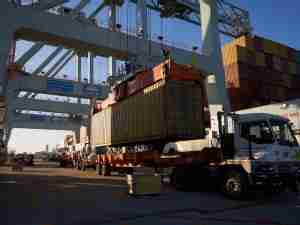We commend the U.S. Department of Transportation (USDOT) for announcing the first-ever National Freight Strategic Plan (NFSP) earlier this month. We believe this historic initiative will go a long way toward strengthening the nation’s competitiveness amidst continued growth in freight demand by laying out a vision for long-term investments in infrastructure, the workforce, and other essential parts of the freight system.
There is no question that America’s ability to compete is dependent on adequate infrastructure to move freight safely and efficiently. Every day, America’s transportation network moves more than 51 million tons of freight and energy products valued at nearly $52 billion via highways, railways, ports and inland waterways, pipelines and airports. The freight network in the St. Louis region annually carries a total of 210 million tons of inbound and outbound freight with a value of $6 billion. The St. Louis Regional Freightway was launched in 2015 to help grow those numbers in the bi-state area, which is the largest freight hub among similarly sized Midwestern cities.
To that end, we’ve been working diligently to enhance the freight network in eastern Missouri and southwestern Illinois to accommodate the anticipated growth here and as a pivotal hub in the national freight network. We are excited to see this plan for improving the safety, security and resilience of the national freight system we are an integral part of. USDOT efforts to build this plan have been in the works for some time and affirm the strategy that has already proven effective in the St. Louis region.
Among the plan’s guiding principles of action for federal involvement in freight policy are some familiar themes, including improving cross-sector, multi-jurisdictional and multimodal collaboration and providing targeted federal resources and financial assistance to support freight projects that provide significant benefits to the national economy.
The St. Louis region is delivering safe and reliable transportation by following these principals through uniting the region toward a common focus by establishing partnerships bridging government boundaries, public and private sector, industries, and modes of transportation. In the last 24 months, nearly one billion dollars have been invested in the region’s roadways, rail, barge terminals and airports. Many of the projects funded have been identified in the St. Louis Regional Freightway’s Priority Projects List, representing key infrastructure needs of the manufacturing and logistics industries in the region. The list is a valuable tool to align and amplify advocacy for support and funding for critical infrastructure improvements, and the process behind creating the list is now recognized as a national model.
The current list includes 21 projects representing a total investment of $2.2 billion, with half that amount covering projects already under construction or funded and expected to get underway. These include the $222 million project to replace the Merchants Bridge, a vital rail artery across the Mississippi River and one of America’s primary east-west rail corridors serving the third largest rail hub in the country – clearly a project with significant benefits to the national economy. The public-private partnership delivering this multimodal rail project is an example of success when you follow the USDOT NFSP. Hundreds of millions more dollars are supporting projects along the Interstate 270 Corridor, which serves the region’s booming e-commerce sector and is one of the nation’s primary east-west manufacturing and logistics corridors.
We also continue to develop partnerships to establish new transportation links with coastal ports in Savannah, Georgia; and southern Louisiana to facilitate the movement of cargo between America’s Heartland and overseas destinations via the inland waterway system with containerized cargo, which will help reduce transportation costs and improve safety.
The St. Louis region has the same goal as the USDOT NFSP to lower costs to businesses and consumers and to boost the competitiveness of American goods abroad, and we will do that by maximizing our strategic location on the Mississippi River. We are within 500 miles of 80% of agriculture and livestock production in the country, home to the Ag Coast of America, home to the nation’s most efficient port system, third largest rail hub in the nation and two international airports.
With USDOT support, we see regions like the bi-state St. Louis area continuing to support the global supply chain through cost effective, fast, and reliable transportation.
Mary Lamie is Executive Vice President of Multi Modal Enterprises at Bi-State Development and heads the St. Louis Regional Freightway.

_-_28de80_-_9b2f972cdce64d5f7c8d952d74a16521db70a589_yes.jpg)





